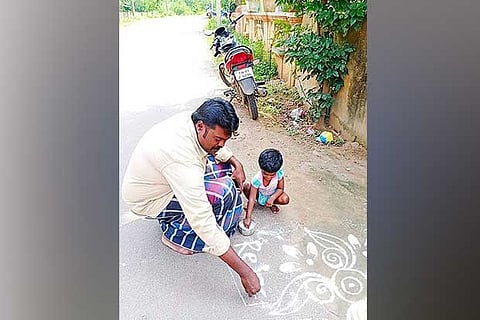

Chennai
UNESCO has categorised kolams under the Representational List of the Intangible Cultural Heritage of Humanity in 2012. Under this list are practices and cultural traditions that do not have any physical records or documentation, and are mainly passed through folklore, tradition, or word-of-mouth.
“The kolam tradition was passed from mother to daughter in the community. It is said to have tribal and folk origins – some believe it is from the Kuravanji tribal tradition. The earliest mention of kolam as a tradition was found in the 13th Century in Tirunelveli,” said art historian Gayathri Iyer.
While Haitian, Australian aboriginal and tribal cultures globally have traditions of drawing on the floor, the purpose of kolams in Tamil Nadu were religious and social. They were drawn on a threshold to ward away bad omens, and beautiful designs were said to attract Goddess Lakshmi. Aesthetically-pleasing kolams were also drawn on the route of a temple procession to please the God, said Iyer.
The social aspect related strongly to the women in the community, she added. “The kolam became the single source of artistic self-expression for women, who were historically prevented from having a public life. Thus, it is tied close to the identity of those women,” added Iyer.
Local artist Krishnapriya CP believes that kolam is an art form. “Modern society has divided art into high art and low art – the former is institutionalised and the latter is available in a more common space. One, however, has to broaden their understanding as these categories cannot apply anymore. Kolam is a legitimate practice and a part of every-day life, and can be categorised as an art form,” she said.
Krishnapriya added that art acts as a site for discussion, debate and speculation, and thus, is important in adding to the current political discourse. With Stalin and Kanimozhi also drawing anti-CAA kolams outside their homes, the question arises if a kolam can be political. According to both Iyer and Krishnapriya, as an art form and a mode of self-expression, a kolam can be political.
Many have criticized the kolams drawn on Sunday as unfaithful to the traditional form, especially due to the inclusion of words. But, Iyer said that this is a result of the evolution of kolam over the years. “A tradition has survived so many years not because it is static, but because it is dynamic and adaptable. That is what the basic definition of tradition is. If a tradition is not dynamic, then it would die out,” said Iyer, adding that there are variants of the kolam even across Indian states, such as the poo kolam drawn in Kerala.
Punishment for self-expression sets a dangerous precedent, said Krishnapriya. “As an artist, this censorship worries me. Trying to homogenise practices and the belief that cultural diversity is not acceptable in our multi-cultural country is scary,” she said.
Visit news.dtnext.in to explore our interactive epaper!
Download the DT Next app for more exciting features!
Click here for iOS
Click here for Android